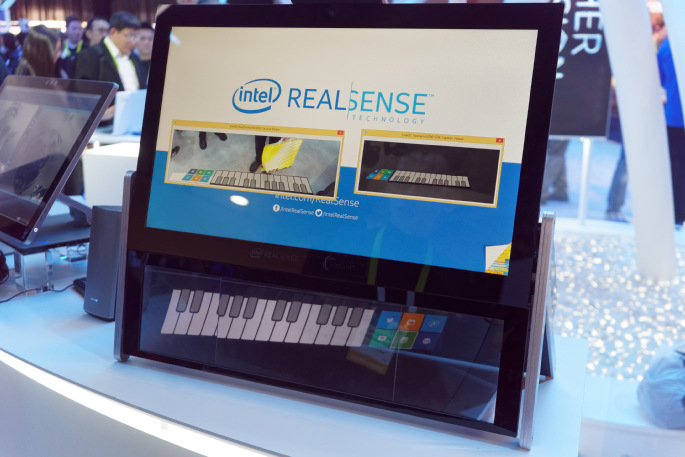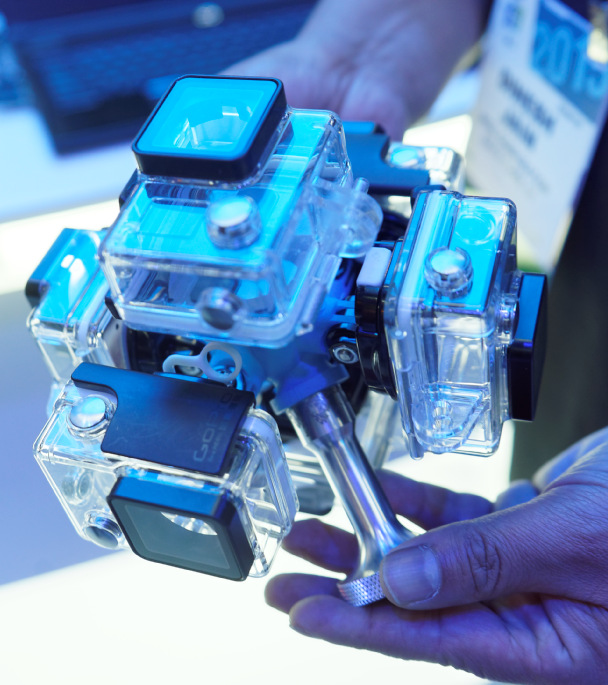Intel’s Brian Krzanich gave a keynote address for the second year in a row. Intel also had a booth with its partners.
In his keynote, Krzanich said that we are on a wave of change that replicates the wave of 1995, when the Intel Pentium Pro was launched, the internet and browsing started to be important for consumers and search engines started to appear and USB was introduced (and we wrote about it in 1995, see DisplayPort and USB). Krzanich said that 2015 means a shift from a 2D world to a 3D world. Up to now, we have been tethered to a 2D display, mouse and keyboard. Now, the RealSense technology provides depth information (see our comments below on the booth visit).
 Intel’s RealSense was used to create this virtual keyboardOne of Krzanich’s assistants showed how the RealSense camera can be used to control a notebook PC with gestures when it is used in the kitchen (but I didn’t find it convincing – Man. Ed.) Seven of Intel’s partners will introduce RealSense-equipped products over the next quarter.
Intel’s RealSense was used to create this virtual keyboardOne of Krzanich’s assistants showed how the RealSense camera can be used to control a notebook PC with gestures when it is used in the kitchen (but I didn’t find it convincing – Man. Ed.) Seven of Intel’s partners will introduce RealSense-equipped products over the next quarter.
Next, Krzanich showed wireless technology for power, Wi-fi, display and peripherals. He then demonstrated password replacement with face recognition and other technologies. Intel and Marriot are introducing wireless charging in some hotels around the world and Intel is working with Hilton, Land Rover Jaguar, SF airport and others to introduce wireless charging. Krzanich said that WiGig for wireless display will be here “this year”.
HP then came on to talk about 3D – what it calls “Blended reality”. HP said there is a “technology chasm” between the 2D world of the PC and the real world. HP then talked about Sprout by HP (HP’s PC Unit Sprouts Anew), which should be a big enabler for new applications from HP partners. HP is also very serious about 3D printing with its Multi-jet fusion technology. The latest units are much faster than previous products from other companies (our friend, Alfred Poor said that until 3D printing goes “raster” rather than “vector”, it won’t be successful – raster always beats vector, in computer displays, printers and other applications).
After talking more about security (a demo on intelligent doorlocks went horribly wrong!), robotics and drones (which use 6 RealSense cameras to create a 360 degree picture of the space around the drone). Krzanich said that wearables are the “next big thing” and are creating new opportunities for innovation. Last year, Intel brought Edison – a computer the size of a postage stamp. This year, they are button sized and he pulled a button off his jacket that is a first prototype of a “Curie” processor. It has a CPU, Bluetooth low energy and various sensors as well as a “recognition engine”. The processor will be available in 2H 2015 and is likely to be widely used in a variety of wearables.
Intel is working with Luxottica (eyewear brands including Oakley, RayBans and others). Last year, the company launched an Airwave goggle system for skiing that provides data to skiiers, including GPS. Colin Baden, CEO of Luxottica (and clearly nervous about his appearance at the keynote) said that the electronics in its eyewear has to reduce as much as possible, so as not to intrude on the wearer’s personal image.
Intel has been working on using wearables to help with vision problems. A member of Intel’s staff has a vision problem that severely restricts his field of view. Intel has developed a wearable jacket which adds vibration (using his touch senses) to give information about the visible world. That means less anxiety, as the user gets a sense of what is happening around them.
Last year, Intel ran a “Make it Wearable” contest and the winner in 2014 was Nixie, a wearable camera. The Nixie camera that is a wearable “drone” camera that can be kept on the wrist, flicked in a direction to take a photo, and then returned to the user (around 59:30 in the video marked above).
There’s a new competition for 2015. Finally, Krzanich talked about the Intel plans to increase the diversity of its workforce. This is the 50th year of Moore’s Law and Gordon Moore was introduced on video to talk about “Moore’s Law”. If cars had developed as fast, since 1965, they would go 300,000 mph, do 2,000,000 miles per (US!) gallon and cost just 4 cents!
 Intel Showed this 360 Camera which used Thunderbolt to capture the video data
Intel Showed this 360 Camera which used Thunderbolt to capture the video data
Intel Booth Visit
I saw some good demos of the Intel RealSense technology, mainly using the new Dell Venue 8 6000 tablet, the first tablet product to include RealSense. I must say that I was surprised how good the RealSense technology is. If the system knows the depth of every pixel, as Intel says, it really does change the value of image capture. After the demo, I kept wishing that my (very wonderful) Sony digital camera knew about the depth of the pixels, so that I could better edit the final photos. Intel might be right, its 3D sensing technology may really be important, but only if it gets into devices that are better at taking photos than tablets!
We particularly liked the facility that some software has, to calculate the size of objects that have been photographed, as it knows the distance and the angle subtended on the imager. As a result, the software can scale objects in an image, compensating accurately for distance perspective – sections of an image are magnified in a scaled way as they get closer in the image – and smaller as they get further away.
There was a demonstration of a 360 degree camera (made from 6 Gopro units) that showed how an interface as fast as Thunderbolt is needed to cope with the level of data needed for this kind of application.

